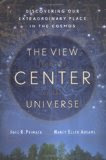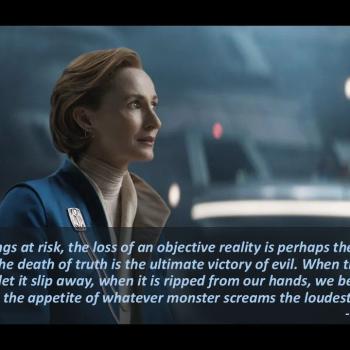 Joel R. Primack and Nancy Ellen Abrams have accomplished something important, and indeed rather remarkable, in their book The View from the Center of the Universe: Discovering Our Extraordinary Place in the Cosmos
Joel R. Primack and Nancy Ellen Abrams have accomplished something important, and indeed rather remarkable, in their book The View from the Center of the Universe: Discovering Our Extraordinary Place in the Cosmos (New York: Riverhead/Penguin, 2006). They seek to offer nothing less than the route to a mythology for our age, one that embraces all of our best scientific knowledge, without understanding it to imply the insignificance of human beings, all the while recognizing that the myths that always fare best are those that draw from the wellsprings of stories and language that human beings already have in place and already find familiar and inspiring.
Here are some quotes and highlights from the book, which progresses through various perspectives and conclusions of the natural sciences, and explores them in relation to religion, ethics, and humanity’s place in the universe in general:
“Traditional religious stories can still arouse a sense of contact with something greater than we are – but that ‘something’ is nothing like what is really out there. We don’t have to pretend to live in some traditional picture of the universe just to reap the benefits of the mythic language popularly associated with that traditional picture…Mythic language is not the possession of any specific religion but is a human tool, and we need it today to talk about the meaning of our universe” (p.11).
“When applied to aspects of the universe far beyond the ordinary conditions on Earth, almost every word is a metaphor. Science is both a consumer and creator of metaphors and is meaningless without thousands of them” (p.15).
 The book argues that there are important respects in which we need to reverse the connotations of two key concepts if we are to do justice to modern cosmology. “Myth” must regain a positive sense, while “common sense” must be demoted as not a reliable guide to the nature of reality (pp.15-16). A key reason is pointed to in the fact that miniatures versions and scale models never work precisely as their actual size counterparts (pp.30-31).
The book argues that there are important respects in which we need to reverse the connotations of two key concepts if we are to do justice to modern cosmology. “Myth” must regain a positive sense, while “common sense” must be demoted as not a reliable guide to the nature of reality (pp.15-16). A key reason is pointed to in the fact that miniatures versions and scale models never work precisely as their actual size counterparts (pp.30-31).
One of the most interesting features of the book is a critique of Thomas Kuhn’s The Structure of Scientific Revolutions (pp.23-25), which gives a misleading impression of how science works. Modern science is not in the same situation as during the Copernican revolution, which is the focus of Kuhn’s book. We have far more data, and the ways in which science makes progress today are not the same.
In a similar way, the “Cartesian bargain” that divided the world into the natural/physical and the spiritual as separate compartments was a brief and problematic hiccup in the history of human thought, a result of the partial understanding of the Newtonian era (pp.78-79).
A nice analogy is made between food and spice on the one hand, and cosmology and myth on the other (p.85). Mythic ideas add spice to our existence, but no amount of spice can make up for the absense of food. We need to find ways of embracing our best understanding of the nature of reality, without understanding this to either exclude the legitimacy and significance of the mythical, or demote human beings as insignificant in the grand scheme of things.
Extensive attention is given to the significance in the universe of small quantities of highly visible matter, but also the importance of larger amounts of largely invisible aspects of the universe. A quote is given from Alan Dressler’s book Voyage to the Great Attractor (Knopf, 1994, p.335; quoted p.120): “If we could learn to look at the universe with eyes that are blind to power and size, but keen for subtlety and complexity, then our world would outshine a galaxy of stars”.
 The range of size scales of the universe is depicted as a cosmic Uroboros (see diagram p.160), and (as far as we can discern) our sort of existence, the scale of intelligent life, occupies a midway point between the largest and smallest – which may in fact themselves connect up in a grand unified theory (pp.161, 174-175). The term Midgard is used to refer to this middle existence of ours.
The range of size scales of the universe is depicted as a cosmic Uroboros (see diagram p.160), and (as far as we can discern) our sort of existence, the scale of intelligent life, occupies a midway point between the largest and smallest – which may in fact themselves connect up in a grand unified theory (pp.161, 174-175). The term Midgard is used to refer to this middle existence of ours.
Other fascinating subjects are explored, such as Kabbalistic ideas of creation, and the possibility that different cosmological models (such as Big Bang, cyclical and steady state) may all be correct in relation to some particular scale.
After exploring both modern science and points of intersection and divergence in relation to traditional religious ideas, the authors invite us to “take our extraordinary place in the cosmos”. They write (p.269): “Cosmic perspective is the greatest gift that modern cosmology gives us. It reveals that the Big Bang powers us all, galaxies and humans alike, in different ways on our respective size-scales. Every one of us is entitled to say, “I am what the expanding universe is doing here and now.” Yet this gift of perspective is not so easy to integrate into daily life. Most people’s cosmic imagery is left over from earlier notions of the universe – the flat earth of the Bible, the heavenly spheres of medieval Europe, or the endless emptiness of Newton’s meaningless universe. We don’t live in those universes. There is real dissonance between the colorful, volatile, science-expanded world we actually inhabit and the monotonously recycled language that religions use to describe “ultimate reality.” Anything described in tired metaphors from an admittedly unreal world must inevitably be accompanied by doubts and eventually boredom and indifference. The lack of a meaningful universe is a modern mental handicap.”
 Having previously stated that the idea of our centrality in the universe is “psychologically correct” even if astronomically wrong (p.133), the authors clarify our extraordinary place in the universe (p.272): “We are at the center of the principles that uphold the universe, and our generation is the first to know it.” Emphasizing that there is nothing in our scientific understanding of the universe itself that requires the view that our existence is or is not meaningful, the authors explain the importance of believing that it is indeed meaningful: “if we resign ourselves to being some minor trash in the universe, we will never see what the universe looks like, because that can only be seen with the mind’s eye, and the mind’s eye works from metaphors that are inaccessible to people who hold the humans-as-trash assumption” (p.274). The point is illustrated slightly later with the joke that “romantics are made of stardust, but cynics are made of the nuclear waste of worn-out stars” (p.279).
Having previously stated that the idea of our centrality in the universe is “psychologically correct” even if astronomically wrong (p.133), the authors clarify our extraordinary place in the universe (p.272): “We are at the center of the principles that uphold the universe, and our generation is the first to know it.” Emphasizing that there is nothing in our scientific understanding of the universe itself that requires the view that our existence is or is not meaningful, the authors explain the importance of believing that it is indeed meaningful: “if we resign ourselves to being some minor trash in the universe, we will never see what the universe looks like, because that can only be seen with the mind’s eye, and the mind’s eye works from metaphors that are inaccessible to people who hold the humans-as-trash assumption” (p.274). The point is illustrated slightly later with the joke that “romantics are made of stardust, but cynics are made of the nuclear waste of worn-out stars” (p.279).
On pp.276-277 there is a helpful exploration of what “God” means in relation to our expanding understanding of the universe. On pp.284-286 there is a similar rethinking of transcendence and the spiritual along similar lines.
This is a fascinating book which offers helpful information, pertinent questions and avenues of reflection, and on the whole a wealth of resources for those seeking to relate religion to our best scientific understanding of the universe of which we are a part. I hope it will help others discover their extraordinary place in the cosmos.












